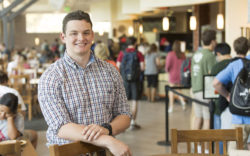When students arrive for their first day at the University of Georgia, they are usually familiar with the history of the school—at least part of it. As UGA’s proportion of minority students has increased, however, there is a growing question of how the university recognizes, or fails to recognize, the African-American contribution to its past.
During the month of February, nationally designated as Black History Month, students gathered to hear a panel of UGA professors and researchers discuss the little-known details of black history on campus, and left challenged to distinguish that history more prominently for all students.
Next to UGA’s famous Arch on Broad Street stands a historical marker in honor of the “War of Southern Independence”—one perspective of the Civil War that both black professors and students are uncomfortable with—only a few yards from another marker in honor of Hamilton Holmes and Charlayne Hunter-Gault, the first two African-American students to enroll at UGA. Other than the nearby Holmes-Hunter Academic Building, there is one memorial for a black person on campus, said Scott Nesbit, assistant professor of digital humanities in the College of Environment and Design. On the back of the Chapel, there is a plaque “honoring a faithful servant of UGA,” Nesbit said. “You can take that for what it is.”
Despite the lack of popular knowledge of African-American history at UGA, there is no doubt

“enslaved people were integral to the working of UGA, and UGA was integral to the lives of enslaved people,” Nesbit said. Today, UGA employs hundreds of people to make sure the university operates, grounds and buildings are maintained and food is cooked, and early in UGA’s history, that work was done by slaves, who made up 50 percent of the Athens population in 1860.
“As far as I can tell from documents, UGA didn’t own enslaved people. Some universities did. UGA had a line-item in its budget that allocated money for hiring a couple hundred people… to maintain the university each year,” Nesbit said. Some of the those employees took advantage of their access to the libraries and educated themselves or, like Lucius Holsey, the slave of a UGA professor, taught themselves to read. Holesy eventually became a prominent bishop in the Colored Methodist Episcopal Church, promoted biracial cooperation and helped establish universities. “Black people took what they could [from UGA] and made the best lives they could,” Nesbit said.
One student said that the first thing she wondered when walking through campus was, “Were there slaves here?” Others commented that their familiarity with black history on campus didn’t stretch beyond Holmes and Hunter-Gault, and they don’t feel compelled to learn the black history of Athens because of the short amount of time they spend here.

Goolsby.
As a native Athenian, Sandra Goolsby is a testament to the ties between UGA and the community. Her own house once served as slave quarters, and her husband’s grandfather would bring books from the UGA library home to read to his children, she said. As an administrative assistant in Multicultural Services and Programs and advisor of 13 multicultural student organizations, she has used her knowledge of the city’s “watering holes, nooks and crannies” to lead tours showing students “where the black people live.”
Yet there is a distance between UGA and the rest of Athens, she said, because for years UGA “tried to shield students from the community and black community.” The community is still bitter because of this isolation, and is not always aware of the steps being made to connect to the community “in our ‘castle of knowledge,’” she said.
It doesn’t help that students are often left in the dark on black history on campus, either. For example, while Holmes and Hunter-Gault are officially considered the first African-American students to enroll at UGA, records reveal that Samuel L. Harris was the first black student to attend UGA decades earlier, Goolsby said.
There are countless more untold stories—and misconceptions—about black history at UGA and in Athens. Through her work as the co-director of the Civil Rights Digital Library initiative, Barbara McCaskill, a professor in the Department of English, has used public records, business inventories, newspapers and genealogies to “read between the lines and find their stories.”

McCaskill.
“I work with the dead—largely 18th and 19th-Century black people who were mostly illiterate, but many of whom walked the paths of the University of Georgia,” McCaskill said. “How do we tell their stories? How do we honor the stories of the lives of the uneducated? It is obligatory that we find a way to tell the whole story of African Americans on campus and in Athens.”
Valerie Babb, professor of English and director of the Institute for African American Studies, echoed the necessity of discovering “the whole story” in any field students may be studying. “In biology, there’s Henrietta Lacks, whose cells are still being used in cancer research. There were blacks shaping the thoughts and lines of our constitution,” she said. “In regards to black history, you are probably touched more by this than you realize.”
Past student groups have attempted to get UGA to formally recognize Harris, but have not succeeded. “We talk about street names and building names, but we don’t know those are the names of racists,” one student said. There is a whole museum dedicated to athletes and a mausoleum for deceased mascots, another student said, but nothing dedicated to recognizing black history at UGA. “It’s a willful ignorance,” McCaskill said.

Babb.
“When I hear ‘Black History Month,’ I always ask, ‘Why?’” Babb said. The UGA community is ensconced in a bubble of white privilege because of the campus environment, she said, so the question is how to move outside of that bubble. “Except for the month of February, we don’t integrate this [black] history and understanding into our everyday lives.”
The panelists encouraged students to push for recognition of minority history on campus. As students, professors, activists and community members endeavor to finish telling the “whole story” of African Americans at UGA and in Athens, McCaskill reminded them that nothing will change “unless you persist.” Her work on the Civil Rights Digital Library Initiative began in 1999, but it wasn’t until 2006 that the project became official, she said. “Sometimes a breakthrough depends on knocking on the right door… We have to have intention to create a life for our projects that will go on beyond our being here.”
Like what you just read? Support Flagpole by making a donation today. Every dollar you give helps fund our ongoing mission to provide Athens with quality, independent journalism.









